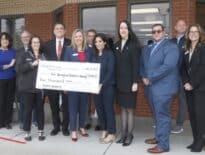
Falling mortgage rates will likely benefit Worcester's housing market more than Greater Boston's, economists say. iStock illustration
Thanks in part to the area’s expensive homes, faster-than-normal home price appreciation and high share of people waiting longer than average to sell their homes, Greater Boston will likely see a slower recovery in home sales even as interest rates fall next year. Worcester, however, could see a much bigger boost in demand.
That’s the conclusion of economists at the National Association of Realtors in a new, metro area-level analysis of the nation’s housing markets’ prospects in 2024.
Top officials at the Federal Reserve are forecasting that they will cut the central bank’s benchmark interest rate 75 basis points, to 3.75 percent, over the course of next year according to predictions released yesterday along with the Fed’s decision to hold rates steady for its third straight meeting. While it’s uncertain just when those rate cuts will arrive, traders on bond markets have already begun reacting to the Fed’s announcement, signalling the potential for mortgage rates to fall from this week’s Freddie Mac average of 6.95 percent for a 30-year, fixed-rate residential loan.
NAR’s report flagged Texas’ biggest metros, along with three Midwest and Southern markets, the Washington, D.C. and Philadelphia areas and Portland, Maine as the 10 markets with the most pent-up demand nation-wide
“The demand for housing will recover from falling mortgage rates and rising income,” NAR chief economist Lawrence Yun said in a statement accompanying his team’s report Wednesday. “In addition, housing inventory is expected to rise by around 30% as more sellers begin to list after delaying selling over the past two years. The selected top 10 U.S. markets will experience faster recovery in home sales.”
NAR’s report combined a number of factors to generate its ranking, including the share of buyers who could afford to return to the market as mortgage interest rates fall, a market’s affordability and the share of high-earning Millennials moving to each market from out-of-state.
Unlike Portland, which several real estate listings portal websites have noted is a major recipient of Boston residents’ out-of-town home searches, only around 3.9 percent of Greater Boston homebuyers could afford to return to the market if mortgage rates fell to 6.5 percent, Yun’s team said. That compares to 5.2 percent in Worcester, 5.1 percent in Austin, Texas – the market with the most pent-up demand according to NAR – and 4.9 percent in Portland.
Nation-wide, that figure is an even 4 percent.
Prices for Boston’s house and condominiums grew faster than the national average year-over-year in the third quarter, NAR said, while only 11.8 percent of renters can afford the region’s current median home price and only 10 percent of October’s listings were affordable to the typical first-time buyer. And while the area attracts a much higher-than-normal share of high-earning young people, 43.5 percent of Boston-area homeowners are staying in their homes longer than average, limiting the number of listings coming onto the market.
Meanwhile in Worcester, 13.2 percent of renters can afford the median-priced home, while 16 percent of October’s listings were affordable to the typical first-time buyer even as its homeowners were also staying put for longer.
Worcester and Springfield were both named to Realtor.com economists’ list of next year’s 10 most likely best-performing housing markets in the nation due to their relative affordability compared to other nearby cities. Realtor.com is operated by Fox News and Wall Street Journal owner News Corp. under a license from NAR.






